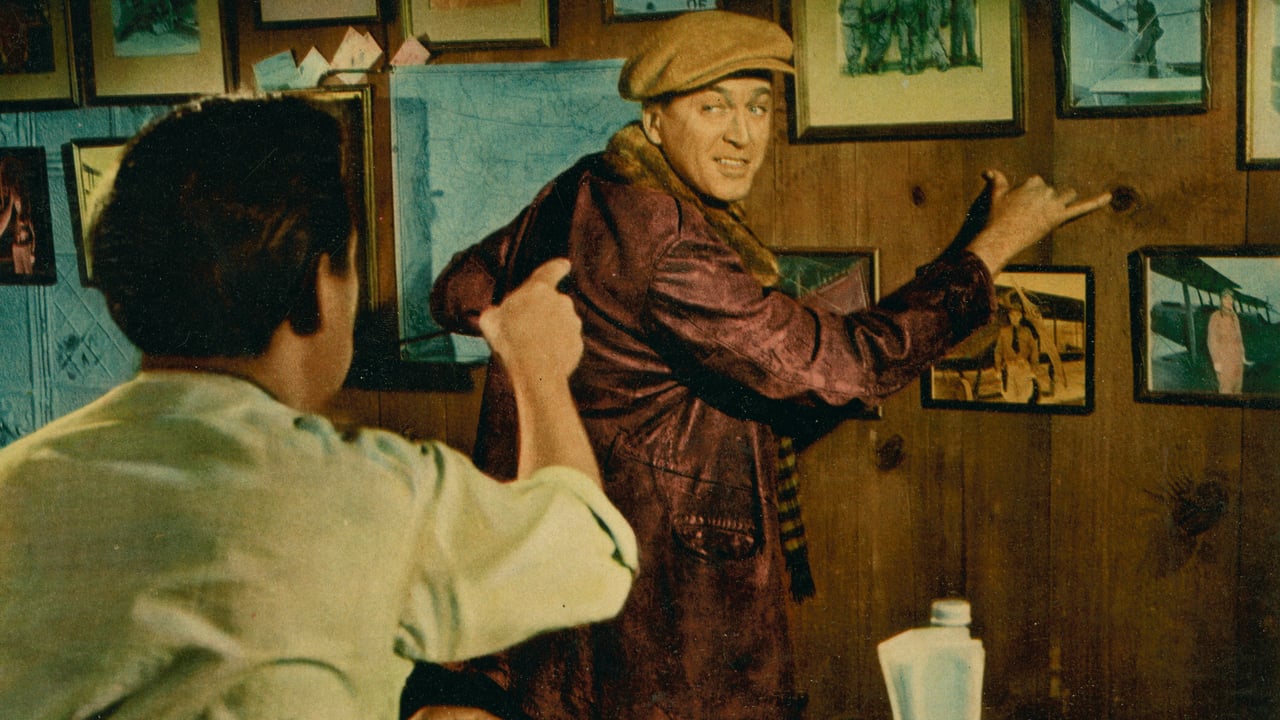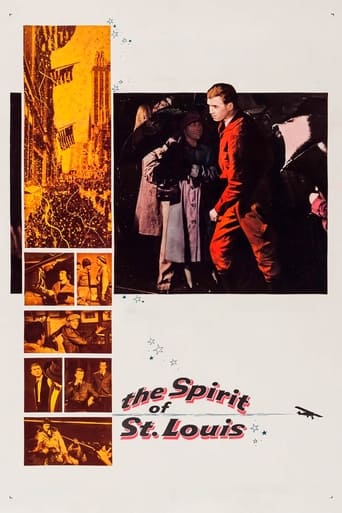Nonureva
Really Surprised!
Exoticalot
People are voting emotionally.
Allissa
.Like the great film, it's made with a great deal of visible affection both in front of and behind the camera.
JohnHowardReid
A Leland Hayward/Billy Wilder Production. Copyright 1957 by Warner Bros Pictures. New York opening at the Radio City Music Hall: 21 February 1957. U.S. release: 20 April 1957. U.K. release: 11 August 1957. Australian release: 31 October 1957. 12,138 feet. 134 dreary minutes.SYNOPSIS: The story is Charles A. Lindbergh's solo flight across the Atlantic Ocean in 1927. As an airmail pilot Lindbergh (Stewart) becomes aware of the possibility of a successful journey across the Atlantic. He struggles to find backers for his project. He finally gets a group of St Louis business men to promote the trip and a single-engine monoplane is built and then named by the backers, "The Spirit of St Louis". NOTES: Negative cost: $6 million. Initial worldwide rentals gross: just over $4 million. Almost all of this money was earned in the domestic market, making it one of the top 25 box-office attractions in the U.S.A./Canada for 1957. The film lost at least $2 million dollars world-wide when you include advertising and release costs.Louis Lichtenfield was nominated for an Academy Award for his Visual Effects, losing to the only other nominee, The Enemy Below.Filmed on location at Santa Monica Airport, Long Island, Manhattan, Guyancourt, near Versailles, and (aerial scenes) along the Great Circle flight-line, August 1955-March 1956.VIEWERS' GUIDE: A sure-fire deterrent for kids who might be tempted to misbehave. "Johnny, you start just one more fight with little Virgil and I'll make you watch The Spirit of St Louis all the way through."COMMENT: It's a sad but inevitable fact of life that yesterday's super-heroes are today's forgotten men and women. Idols usually do not span generations.
There are many reasons for this, but I guess the principal ones are that the new generation is naturally suspicious of the values of the old and - at the other end of the scale - that historical accomplishments have no elements of suspense. We know Lindy is going to successfully overcome all sorts of obstacles to get his plane ready and then accomplish the mission. So I'm not surprised the picture failed at the box-office. I'm not saddened either, because in a way it deserved its fate. The picture is made in a very craftsmanlike fashion - and on a spectacular budget too - but for the most part it's very stolidly and unimaginatively put together. The take-off sequence is inventively and suspensefully cut, but why wasn't the whole film? It could have come in at a third the length and given us as much information, but three times the thrillsWhile Wilder is to be commended for not throwing in a spurious love interest, the net result is to focus all the film's attention on James Stewart. If you're a Stewart fan, fine. He's in just about every frame. All the other players have miniscule roles.Director Wilder fans, however, are advised to avoid this plodding Spirit. There is precious little wit and no incisive social comment here.OTHER VIEWS: With eight box-office hits in a row behind him, it seemed unlikely that-James Stewart would give Warner Brothers what Jack L. Warner a few years later called "the most disastrous failure we ever had". - Allen Eyles in James Stewart.
utgard14
Biopic of Charles Lindbergh, directed by Billy Wilder and starring James Stewart as the famed aviator. The story focuses mainly on his transatlantic flight with flashbacks interspersed throughout. It's not a bad movie by any stretch, just overlong and a little dull at times. One of the more traditional and, I suppose for many, uninteresting of Wilder's films. Stewart is too old for the role but the bigger problem is that he's never convincing here as anything other than Jimmy Stewart. That being said, he is always enjoyable to watch and since a lot of this film is him alone he really gets a chance to shine, even if he doesn't hit the mark on capturing Lindbergh. It's not like the script does him much favor in that regard, anyway.I won't complain about historical inaccuracies, nor about sanitizing Lindbergh's story. I've said many times in reviews for other biopics from Hollywood's Golden Age that this is not something that bothers me. The goal of these movies was to entertain. Whatever educational value they have is far down on the priority list. As long as the filmmakers are not going out of their way to assassinate someone's character or something along those lines, I don't have any issues with granting them artistic license with these types of films. Anyway, this is a flawed but ultimately enjoyable movie. There's comedy and drama and a little suspense. I enjoyed the plane stuff and any special effects used in those scenes. It's definitely worth a look for Stewart and Wilder fans, or people who enjoy old-fashioned biographical pictures that they don't make anymore.
ma-cortes
Overlong though exciting story behind the story of Lindbergh's incredible flight from New York to Paris. It deals Charles 'Slim' Lindbergh (excellently performed by James Stewart , he always wanted to portray him , when he ultimately got his chance is very old for a young role ; he was given this character after John Kerr had turned it down, owing to his disapproval of Lindbergh's pro-Nazi sympathies and his racist and anti-Semitic views) struggles to finance and design an airplane that will make his New York to Paris flight the first solo transatlantic crossing . As a 25-year-old U.S. Air Mail pilot, Lindbergh (Charles wanted Anthony Perkins to play him in the movie) emerged suddenly from virtual obscurity to instantaneous world fame as the result of his Orteig Prize-winning solo nonstop flight on May 20–21, 1927, made from the Roosevelt Field in Garden City on New York's Long Island to Le Bourget Field in Paris, France, a distance of nearly 3,600 statute miles or 5,800 km , in the single-seat, single-engine purpose-built Ryan monoplane Spirit of St. Louis . As a result of this flight, Lindbergh was the first person in history to be in New York one day and Paris the next.Interesting picture with plenty of thrills , emotion , biographic elements and brief touches of humor . The film is pretty well though the action does drag at times and results to be overlong . Magnificent acting by James Stewart -at age 48- who gives a real Tour De Force back by good plethora of secondaries . However , many critics felt he was too old to be believable . In fact , producer Jack L. Warner was strongly opposed to the casting of James Stewart, which he believed caused the film to flop on its release in 1957 . Colorful and evocative cinematography in CinemaScope by two awesome cameramen Peverel Marley and Robert Burks , Hitchcock's ordinary . Impressive and thrilling musical score by Franz Waxman . However , the soundtrack was re-composed but composer Franz Waxman was no longer available so veteran film composer Roy Webb was hired along with Warner Brothers Music Director Ray Heindorf to come up with new cues based on Waxman's original material . The motion picture was compellingly directed by Billy Wilder , but it was a box office flop when originally released . After the film received bad notices from preview audiences, it was extensively re-edited with some new footage shot . Rating : Above average , this one remains a quality movie for the whole family . This exciting and inventive picture well well based on true events , these are the followings : Six well-known aviators had already lost their lives in pursuit of the Orteig Prize when Lindbergh took off from Roosevelt Field on his successful attempt in the early morning of Friday, May 20, 1927. Burdened by its heavy load of 450 U.S. gallons of gasoline weighing about 1,230 kg, and hampered by a muddy, rain-soaked runway, Lindbergh's Wright Whirlwind-powered monoplane gained speed very slowly as it made its 7:52 am takeoff run, but its J-5C radial engine still proved powerful enough to allow the Spirit to clear the telephone lines at the far end of the field "by about twenty feet or six meters with a fair reserve of flying speed". Over the next 33.5 hours, he and the Spirit faced many challenges, including skimming over both storm clouds at 10,000 ft , 3,000 m, and wave tops at as low at 10 ft (3.0 m), fighting icing, flying blind through fog for several hours, and navigating only by the stars , whenever visible , and dead reckoning before landing at Le Bourget Airport at 10:22 pm (22:22) on Saturday, May 21. The airfield was not marked on his map and Lindbergh knew only that it was some seven miles northeast of the city. He initially mistook the airfield for some large industrial complex with bright lights spreading out in all directions. The lights were, in fact, the headlights of tens of thousands of cars all driven by eager spectators now caught in "the largest traffic jam in Parisian history " . A crowd estimated at 150,000 spectators stormed the field, dragged Lindbergh out of the cockpit, and literally carried him around above their heads for "nearly half an hour".
Sonya Troncoso
"The Spirit of St. Louis" is an entertaining gripping film of Charles Lindbergh and the first transatlantic flight from New York to Paris in May 1927. The film directed by the talented Billy Wilder is quite good, from impressive aerial cinematography to James Stewart in one of his best acting performances. The "Spirit of St. Louis" funded by businessmen from St. Louis, and designed in large part by Lindbergh, propels him through extraordinary moments and some close calls documented in the 33 1/2 hours of his famous flight. Once Lindbergh departs from New York, the audience is whisked up in the air and is treated to colorful scenes of his early beginnings as he reminisces on board the plane. The flashbacks showcase Lindbergh's experiences and provides the viewer an insight into his love affair with aviation. The last few hours of Lindbergh's flight are intense. Not only does the film document when the "Spirit of St. Louis" begins to accumulate ice on its wings, but portrays the incredible toll on Lindbergh of sheer exhaustion as he desperately fights from falling asleep. The film culminates with his famous landing to Le Bourget Field outside of Paris greeted by cheering crowds of thousands, followed by a hero's welcome in America woven with footage of the real event. The magnitude of Lindbergh's heroism and historic flight are beautifully captured in this movie. The way this film is shot, along with Jimmy Stewart's natural reactions and incredible performance as he narrates Lindbergh's thoughts, makes this journey a flight not to be missed!

